10th Anniversary of Establish of the (Korean) Government
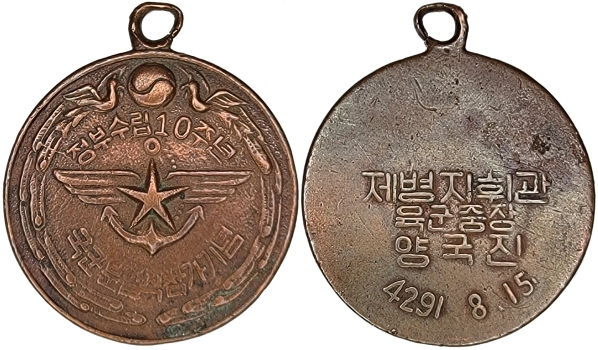
국군분열식참가기념 “Commemoration of Participation in the Armed Forces Division Ceremony”
Reverse: 제병지휘관 “Troop Commander”, 육군중장 “Lieutenant General”, 양국진 “Yang Kuk-Jin”
4291.8.15 “Aug. 15, 1958”
On the surface, this pendant / fob is not that exciting. It only marks the military parade that took place on Aug. 15, 1958, but it does bring up an ongoing controversy that is currently taking place in Korea. Aug. 15, 1958 did celebrate the 10th anniversary of the founding of the South Korean government, but it was also the 13th Anniversary of Korea’s Liberation from Japanese rule. On that day in 1945, the Japanese announced their unconditional surrender, marking the end of World War II. So, in South Korea, Aug. 15th is both the Korean Liberation Day and the Korean Independence Day. This Liberation day is the only Korean holiday that is celebrated by both North and South Korea. In South Korea, it is known as (Lit.) “The Day the Light Returned” 광복절 (光復節). While in North Korea it is known as “Liberation of the Fatherland Day” 조국해방의 (祖國解放의). The South Koreans use the term “restoration” 복 instead of “independence” 독립 to emphasize that Korea had been independent for centuries before Japanese rule. To snub the North Koreans, the South Korean government has always maintained that they are the legitimate heir of the Korean Provisional Government. So, the question becomes: When was the South Korean Government Founded? Was it Aug. 15th 1948 or Apr. 11, 1919, when the Korean Provisional Government was first founded in Shanghai, China. Polls in Korea find that approx. 60% of its citizens consider 1919 as the foundation of the South Korean government.
The reverse of the fob has the name of Lieutenant General Yang Kuk-Jin 양국진 (楊國鎭1916-1981). In March 1937, he entered the Japanese Central Army Training, Processing, and Accounting Department. In December 1938, he graduated from the 6th class of the Central Army Training Service. He graduated from the 2nd class of the Army Military School in Shinkyo. He took the Japanese name Kokujin Nakahara. In March 1942, he was made a munition’s lieutenant. At the end of World War II, on August 17, 1945, he returned to Seoul by plane, interestingly enough, in his Japanese uniform. In January 1946, he graduated from the Military English School and was appointed a lieutenant. On January 4th, of the same year, he became the Chief of the Munitions Division at the Army Headquarters. On July 15, 1948, he was appointed Inspector General of the Army Headquarters. On January 3, 1949, he was promoted to Colonel and appointed Chief of the Munitions Bureau at the Army Headquarters. In June 1950, when the Korean War broke out, he was responsible for munitions support, and was listed as a person of merit. In September of the same year, he was promoted to Brigadier General and on May 26, 1951, he was made Deputy Chief of Administrative Staff at Army Headquarters. In 1952, he became the deputy commander of the 2nd Corps. In September of the same year, he became a Major General. He graduated from the U.S. Army Command and General Staff College in 1954 and served as Deputy Chief of the Administrative Staff at the Army Headquarters. In 1955, he was appointed Commander of the 2nd Training Center, and in July 1957, Commander of the 1st Corps. By this time, he was a Lieutenant General, but I have not been able to find his date of promotion. On July 6, 1959, he became commander of the 3rd Corps. In April 1960, he was arrested on suspicion of illicit enrichment, but was soon released. As a result of the April 19 (1960) Revolution, Syngman Rhee’s First Republic collapsed. This was subsequently followed by the May 16th, 1961 Military coup d’état in South Korea. Yang Kuk-Jin was arrested again, as a corrupt soldier, and referred to a Revolutionary Tribunal. In 1962. He was sentenced to 10 years in prison, but again, was soon released. In 1966, he became the vice president of Daehan Integrated Food Company, and the following year he became the president of the company. In 1981, he died at the age of 64. On April 29, 2008, the National Institute for Ethnic Issues and the Pro-Japanese Biographical Dictionary Compilation Committee announced that he was to be listed in the military section of pro-Japanese biographical dictionary. I have been unable to find a list of his decorations. I did find that he was given the Legion of Merit on October 24, 1951, for exceptionally meritorious conduct in the performance of outstanding services to the Government of the United States from 24 June to 14 October 1950.

건군13주년기념 Commemoration of the 13th anniversary of the founding of the armed forces
4294.10.1
국방장관 Secretary of Defense
Reverse:
13th Armed Forces Day
1 Oct. 1961
Ministry of National Defense
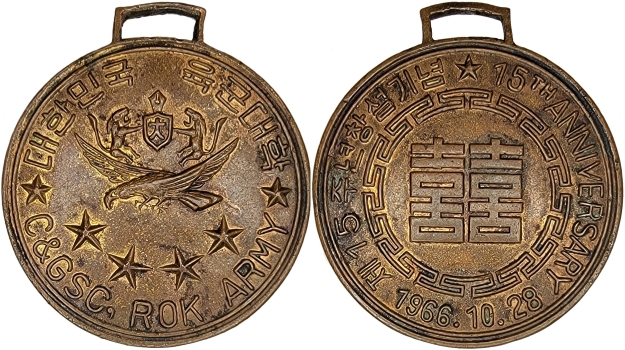
대한민국 육군대학 Republic of Korea Army University
C & GSC, ROK ARMY Command and General Staff College, ROK Army
Reverse:
In the center is the Chinese character 囍 Meaning “Double Joy or Double Happiness”
제15주년장설기념 15th anniversary celebration
Then in English 15th Anniversary and at the bottom, the date 1966.10.28
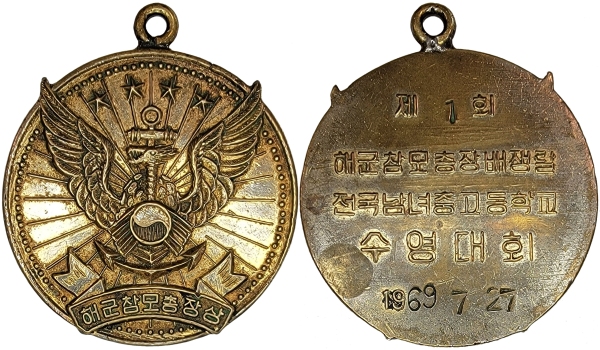
해군참모총장상 Chief of Naval Staff Award
Reverse:
제 1 회 First (Place/Meet?)
해군참모총장상 Chief of Naval Staff Award
전국남녀충 고등학교 National Male and Female High School
수영대회 Swim Meet
1969.7.27
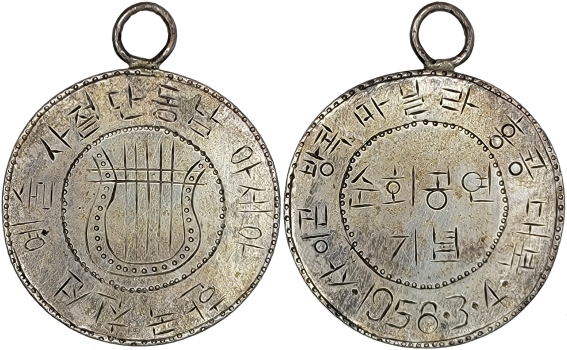
Korea Friendship Art Mission Southeast Asia – 1958
The obverse inscription translates as: Korea Friendship Art Mission Southeast Asia 예술사절단동남아세아 한국친선. In the center of the reverse, the inscription reads: Commemorative Tour 순회공연기념. Along the outer edge is: Saigon, Bangkok, Manila, Hong Kong, Taipei 사이곤 방콕 마닐라 홍콩 대북 and at the bottom is a date 1958•3•4.
In doing the research, the date at the bottom is problematic. Depending on the source, the tour lasted from Feb. 22nd to Apr. 14th, 1958. There is another source that states that the final performance was in Taegu, Korea on Apr. 22nd. The Korean art troupe gave their first performance at the Daenam Theater in Saigon on March 5th. I believe that the date at the bottom of the reverse actually refers to March and April 1958, the months that they were actually performing and not in transit. This makes sense when you consider that to travel from Korea to Saigon at 10 knots, takes 10.5 days by ship, putting their earliest arrival date at March 4th.
The tour included dancing, singing, and orchestral performances. There was also a Korean Marine Corps Band and Precision Drill Team. The tour also included Korean contemporary paintings. In all, there were 270 members in the tour group. I do not know if that number includes the personnel who manned the Korean navy ship they were used. Kim Baek-bong 김백봉 (金白峰) did the choreography for the Southeast Asian Tour. She holds a special place in the history of Korean Dance.
This commemorative medal is hand made and fairly crude. Keep in mind that Korea at that time was unable to produce their own coinage. The very first South Korean coins were issued by the government in 1958, and they were produced by the United States Mint.
Click here to see a contemporaneous film of the tour.
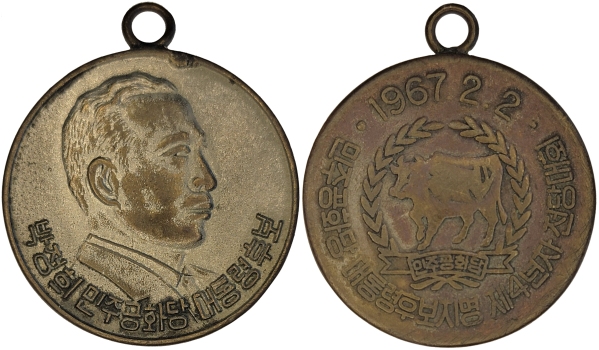
Presidential candidate, Park Chung-hee
On the obverse of the medal at the right is: 박정희민주공화당대통령후보 Democratic Republican Party presidential candidate Park Chung-hee. On the reverse, there is the date: 1967.2.2 with the inscription: 민주공화당 대통령후보지명 제4년자 전당대회 Democratic Republican Party Presidential Candidate Nomination 4th National Convention. The center wreath, bull and banner with the inscription 민주공화당 (Democratic Republican Party) was the official emblem of the party.
The Democratic Republican Party was Founded on Feb. 26, 1963, shortly after Park Chung-hee, took political power through the 5.16 military coup in 1961. The party was formed because Park Chung-hee wanted a political party with an established and strict leadership system, so conflicts or protests within the party could not be organized. After candidate Park Chung-hee became president in 1963, the party was the ruling political party in South Korea for 17 years until it was dissolved/disbanded on October 27, 1980, by the new military government. This was almost a year after Park Chung Hee’s assassination on Oct. 26, 1979. After the dissolution, the Democratic Justice Party, the Korean People’s Party and the New Democratic Republican Party were formed. Until July 2015, it was the longest-serving political party in South Korean history.
